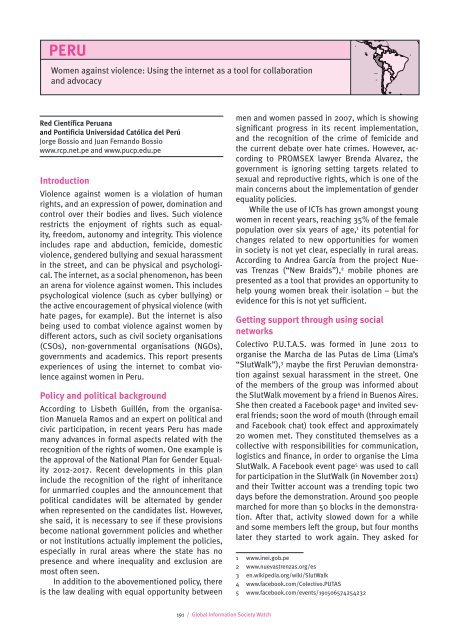gisw13_chapters
gisw13_chapters
gisw13_chapters
Create successful ePaper yourself
Turn your PDF publications into a flip-book with our unique Google optimized e-Paper software.
PERUWomen against violence: Using the internet as a tool for collaborationand advocacyRed Científica Peruanaand Pontificia Universidad Católica del PerúJorge Bossio and Juan Fernando Bossiowww.rcp.net.pe and www.pucp.edu.peIntroductionViolence against women is a violation of humanrights, and an expression of power, domination andcontrol over their bodies and lives. Such violencerestricts the enjoyment of rights such as equality,freedom, autonomy and integrity. This violenceincludes rape and abduction, femicide, domesticviolence, gendered bullying and sexual harassmentin the street, and can be physical and psychological.The internet, as a social phenomenon, has beenan arena for violence against women. This includespsychological violence (such as cyber bullying) orthe active encouragement of physical violence (withhate pages, for example). But the internet is alsobeing used to combat violence against women bydifferent actors, such as civil society organisations(CSOs), non-governmental organisations (NGOs),governments and academics. This report presentsexperiences of using the internet to combat violenceagainst women in Peru.Policy and political backgroundAccording to Lisbeth Guillén, from the organisationManuela Ramos and an expert on political andcivic participation, in recent years Peru has mademany advances in formal aspects related with therecognition of the rights of women. One example isthe approval of the National Plan for Gender Equality2012-2017. Recent developments in this planinclude the recognition of the right of inheritancefor unmarried couples and the announcement thatpolitical candidates will be alternated by genderwhen represented on the candidates list. However,she said, it is necessary to see if these provisionsbecome national government policies and whetheror not institutions actually implement the policies,especially in rural areas where the state has nopresence and where inequality and exclusion aremost often seen.In addition to the abovementioned policy, thereis the law dealing with equal opportunity betweenmen and women passed in 2007, which is showingsignificant progress in its recent implementation,and the recognition of the crime of femicide andthe current debate over hate crimes. However, accordingto PROMSEX lawyer Brenda Alvarez, thegovernment is ignoring setting targets related tosexual and reproductive rights, which is one of themain concerns about the implementation of genderequality policies.While the use of ICTs has grown amongst youngwomen in recent years, reaching 35% of the femalepopulation over six years of age, 1 its potential forchanges related to new opportunities for womenin society is not yet clear, especially in rural areas.According to Andrea García from the project NuevasTrenzas (“New Braids”), 2 mobile phones arepresented as a tool that provides an opportunity tohelp young women break their isolation – but theevidence for this is not yet sufficient.Getting support through using socialnetworksColectivo P.U.T.A.S. was formed in June 2011 toorganise the Marcha de las Putas de Lima (Lima’s“SlutWalk”), 3 maybe the first Peruvian demonstrationagainst sexual harassment in the street. Oneof the members of the group was informed aboutthe SlutWalk movement by a friend in Buenos Aires.She then created a Facebook page 4 and invited severalfriends; soon the word of mouth (through emailand Facebook chat) took effect and approximately20 women met. They constituted themselves as acollective with responsibilities for communication,logistics and finance, in order to organise the LimaSlutWalk. A Facebook event page 5 was used to callfor participation in the SlutWalk (in November 2011)and their Twitter account was a trending topic twodays before the demonstration. Around 500 peoplemarched for more than 50 blocks in the demonstration.After that, activity slowed down for a whileand some members left the group, but four monthslater they started to work again. They asked for1 www.inei.gob.pe2 www.nuevastrenzas.org/es3 en.wikipedia.org/wiki/SlutWalk4 www.facebook.com/Colectivo.PUTAS5 www.facebook.com/events/191506574254232191 / Global Information Society Watch


